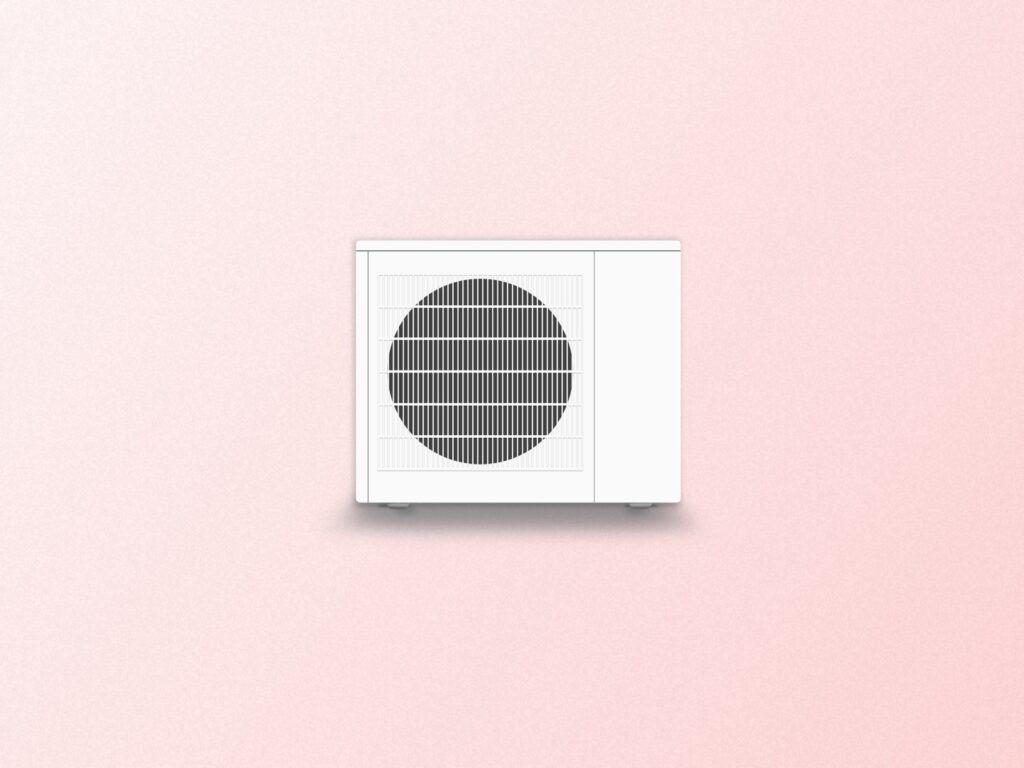Going beyond “It depends”
Ask how much a heat pump costs and you’ll likely receive more questions than answers. Where do you live? How big is your home? Do you need a ducted system or ductless mini-splits? Are there rebates in your state? What’s your electrical panel setup?
But hearing an answer like “It depends” is frustrating when you’re eager to move ahead. That’s why we embarked on a months-long effort to provide more context and data on how much heat pumps and mini-splits cost.
We surveyed 125 homeowners across the United States and Canada, reviewed previous research, spoke with experienced installers, and analyzed publicly available data from states like Massachusetts and California. Here’s what we learned:
Average cost of a heat pump
According to our survey and analysis of other data, homeowners can expect a heat pump installation to cost between $3,500 and $20,000, depending on the size of their home, with an average cost of about $14,000, after rebates.
Ductless mini-split installations cost between $7,000 and $25,000, depending on the number of zones, with an average cost of just over $12,000, after rebates.
What impacts heat pump costs most?
Home size
Unsurprisingly, the biggest heat pump installation cost factor is home size. In our survey, here’s how much the average homeowner paid based on their home’s square footage:
- Less than 1,000 square feet: $3,586
- Between 1,000 and 1,500 square feet: $11,749
- Between 1,500 and 2,000 square feet: $16,933
- Between 2,000-2,500 square feet: $17,826
- More than 2,000 square feet: $19,117
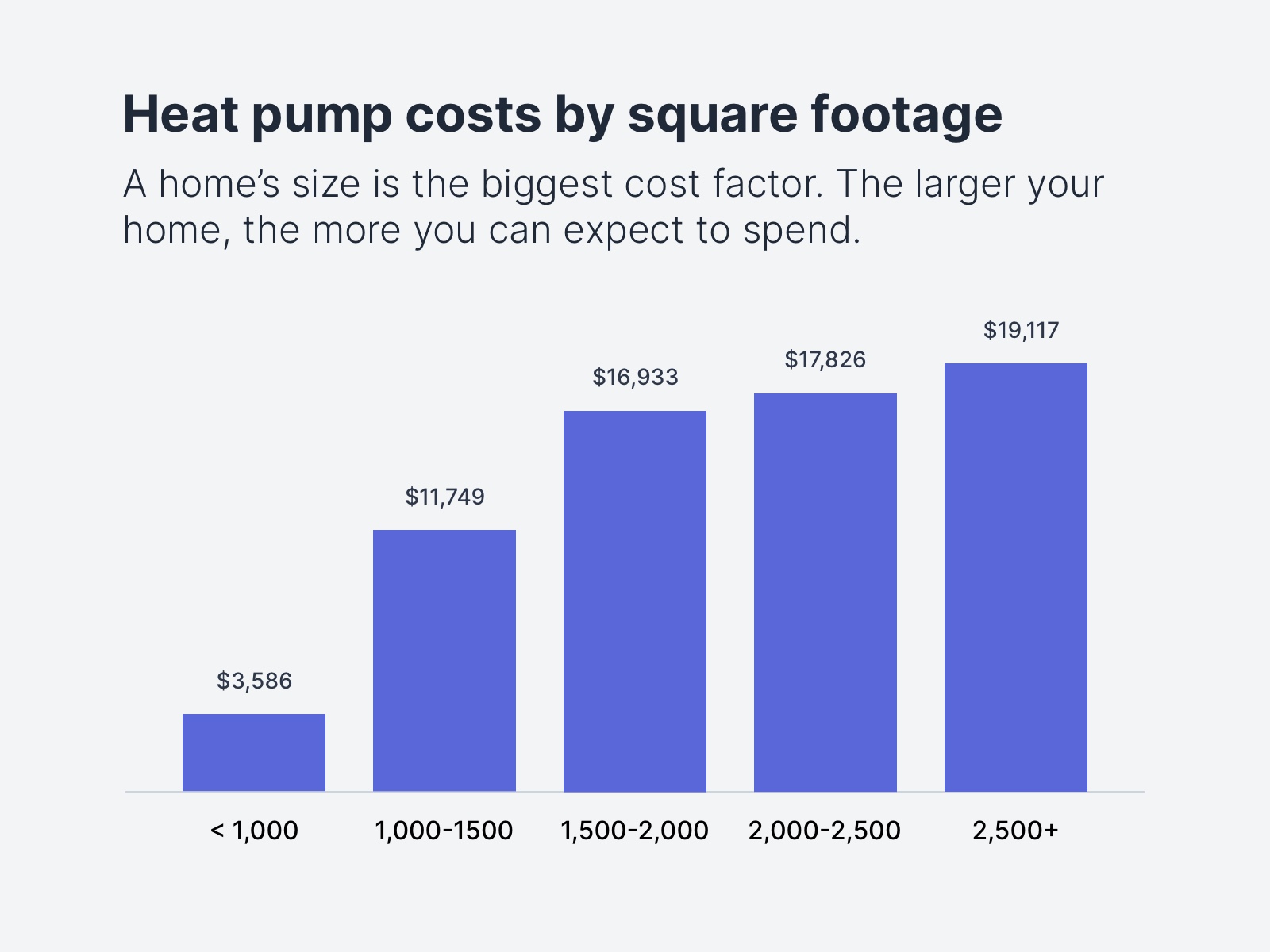
Across all the homeowners we surveyed, there was a sizable difference in the cost per square foot. More than half of homeowners paid between $4-10 per square foot, with the most common installation costing between $4-6 per square foot.
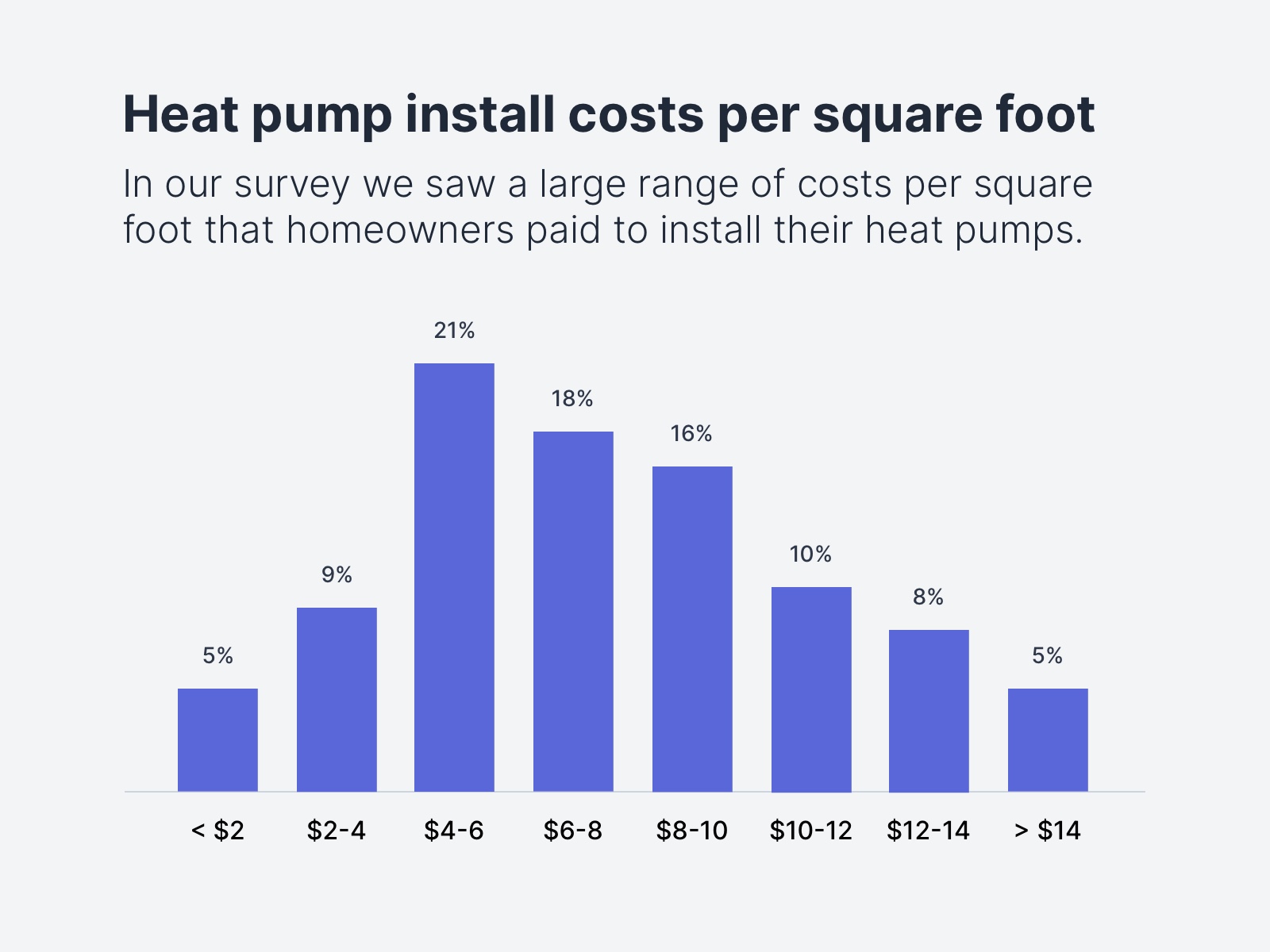
It’s worth noting that the sample size of homes under 1,000 square feet was very small in our survey, at just under 10 homes. When we analyzed publicly available data on heat pump costs in Massachusetts and California (the rare states that actually disclose where their rebate dollars go), we found that homes under 1,000 square feet paid about $9,000 and $12,774 respectively.
Number of zones
The second most influential factor in our survey was the number of zones a homeowner installed. Here’s how much the average homeowner paid based on the number of mini-split zones:
- 1 zone: $7,101
- 2 zones: $11,749
- 3 zones: $13,827
- 4 zones: $18,338
- 5+ zones: $26,573
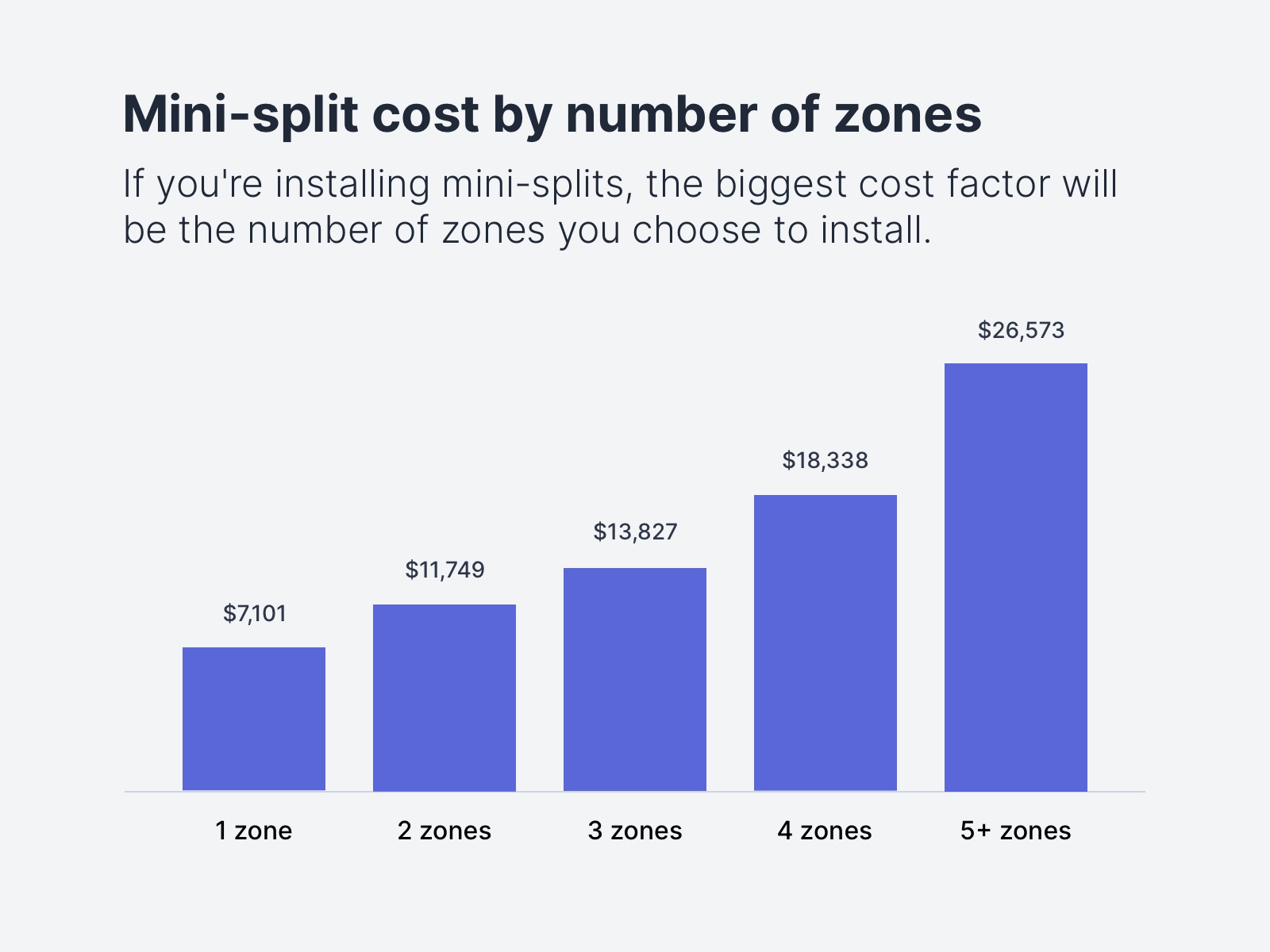
The reason for these cost differences is simple: more zones require more labor, equipment, and parts. The outdoor unit needed for heating and cooling gets pricier as you add indoor units, especially once you move past the single-zone models. And each mini-split unit inside your house costs about $1,000-$2,000.
In addition to those costs, the larger the home, the more drywall and electrical work required to connect the units, said David Richardson, a heat pump installer and co-founder of Elephant Energy.
Finally, older homes switching to heat pumps may have to upgrade their electrical panel to accommodate the new power demands. More on that just a bit further on.
Location
Another major factor that affects the cost of heat pump installations is the location of a home.
The average homeowner we surveyed paid $8.01 per square foot, after rebates. But among the states we analyzed, we saw a range of $6.75 per square foot (Minnesota) to $9.64 per square foot (Colorado).
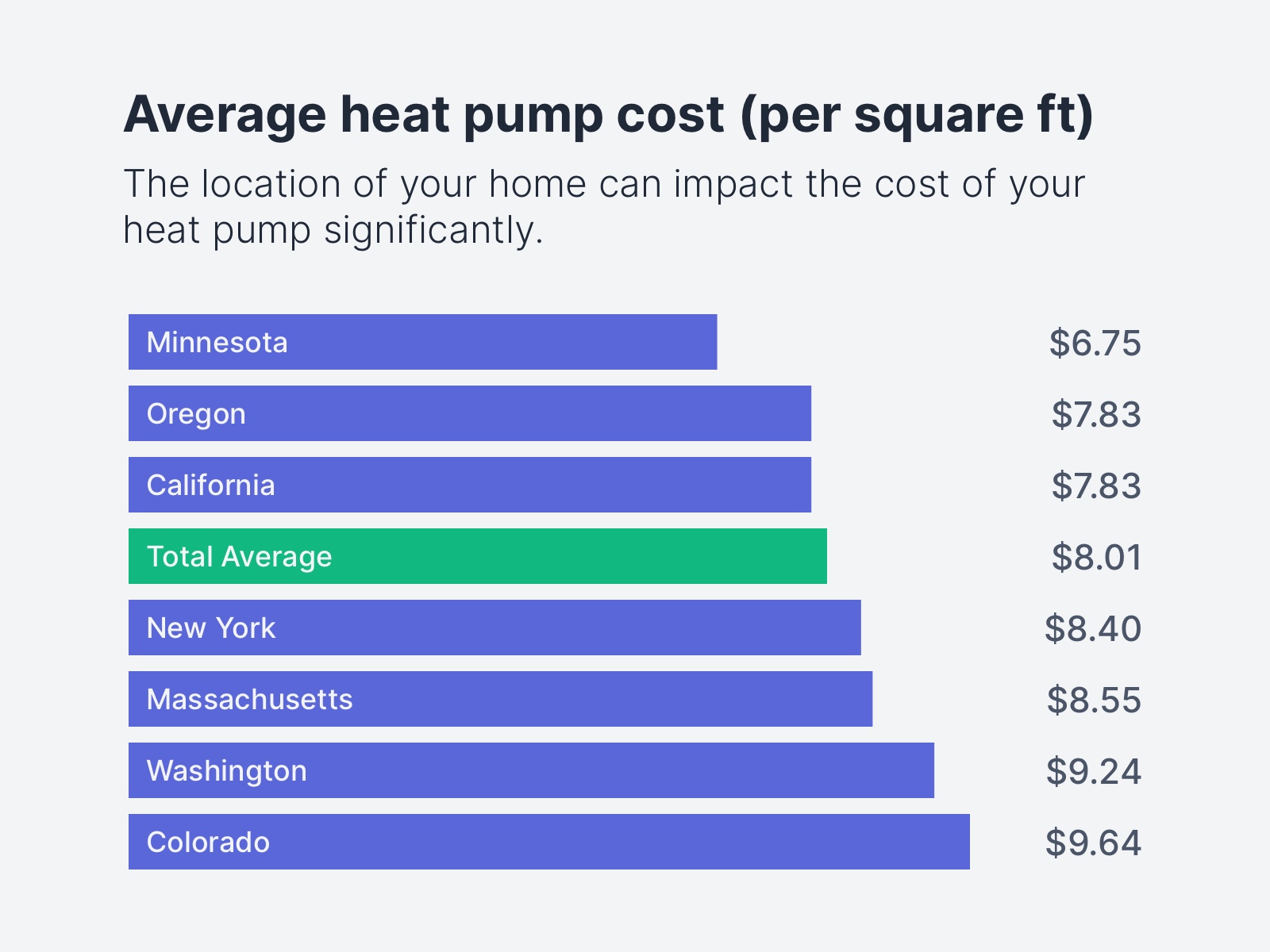
It’s worth noting here again that our sample size was relatively small. Given that no one else has done a state-by-state comparison of heat pump costs, it’s hard to say how representative our data is.
In addition to comparing individual states, we compared costs across different regions of the United States. Across the south, where heat pumps are more common, costs averaged $7.33 per square foot. In the midwest, the average was $7.44 per square foot. Meanwhile, in the Northeast and West, costs were over $8 per square foot.
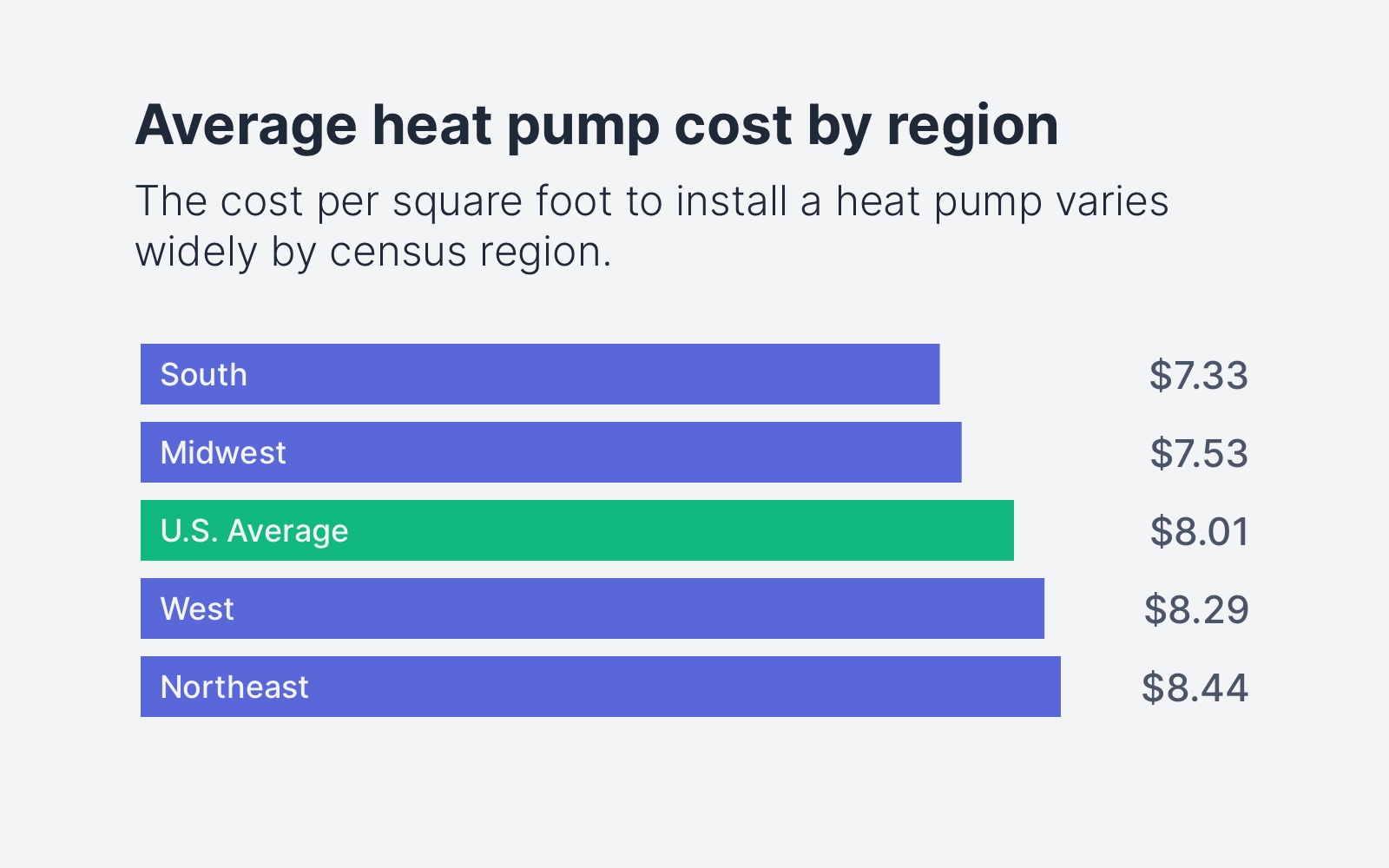
But those are averages. We recently spoke with an installer in Westchester, New York, one of the most expensive places to live in the US. The average heat pump they install costs more than $30,000. We’ve heard similar stories of high installation costs and quotes in San Francisco.
Rebates and incentives
One of the biggest wildcards in the heat pump cost equation is whether or not you qualify for rebates and incentives. This depends largely on which state and utility service area you live in.
In our survey, the rebates homeowners received ranged from $0 to as much as $14,000, with an average rebate of about $1,500.
Our survey, and Massachusetts’ database, focus on the cost of installations after rebates and other incentives. State by state, utility by utility, these can make a big difference in the cost of your system.
In Massachusetts, homeowners can receive up to $10,000 in rebates. Even if your state doesn’t seem to offer rebates, check with your energy provider. Central Hudson (upstate NY) customers can receive $1,000 per 10,000 BTUs if they replace a fossil fuel heating source, so at least $3,000 for a typical 3-ton system. Even in conservative South Dakota utilities offer rebates.
Check the DSIRE database as a starting point in your search for state, local, and utility incentives, but be sure to look further, too.
New versus old homes
Another big difference we found in our survey was the cost of heat pumps in new construction homes compared to existing homes.
In our survey, the average heat pump in new home construction was $7,384 after rebates and $6.54 per square foot. By comparison, the average heat pump installed in an existing home was $15,113 after rebates and $8.15 per square foot.
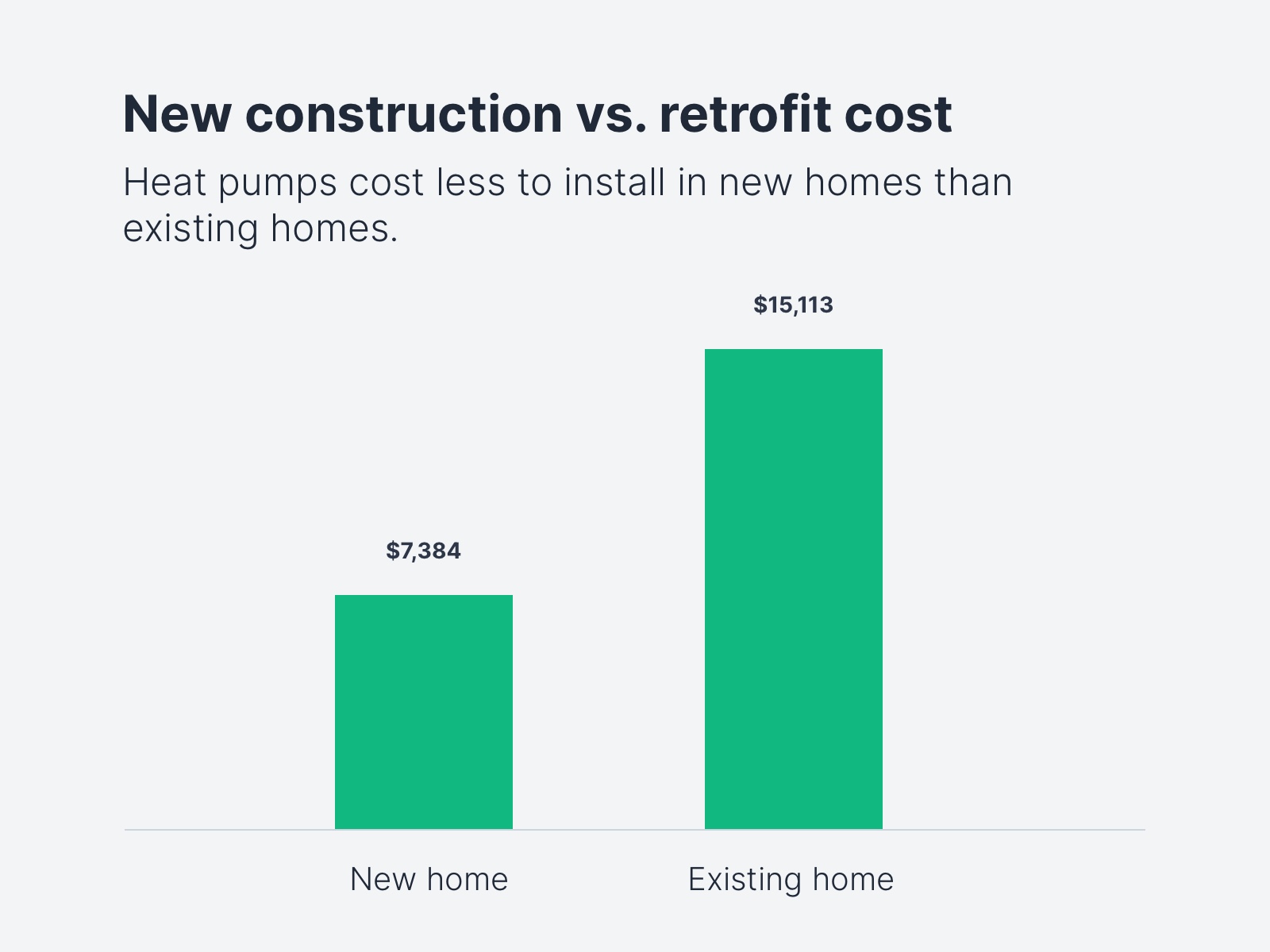
So why do these costs vary?
Building a new home allows a developer or homeowner to plan ahead. They can install the right electrical service to support an electrified home. Ducts and mini-split lines can be run while the walls are still open. And the home can have exactly as many vents or indoor units as are needed.
Prior heating and cooling system
One factor that didn’t affect the average cost of installation as much as we expected was what equipment homeowners were replacing.
Replacing a fossil fuel heating system with an electric heat pump can add electrical work and upgrade costs to your HVAC tab. That’s part of the reason installations in the South are less expensive: the homes are often already wired for electrical heating.
But our survey didn’t show a large difference in installation costs. Here’s how much the average homeowner spent based on what type of equipment they replaced:
- Fuel oil heating system: $11,640
- Central air conditioner: $14,572
- Natural gas heating system: $15,161
- Propane heating system: $16,000
- Other heating system: $17,451
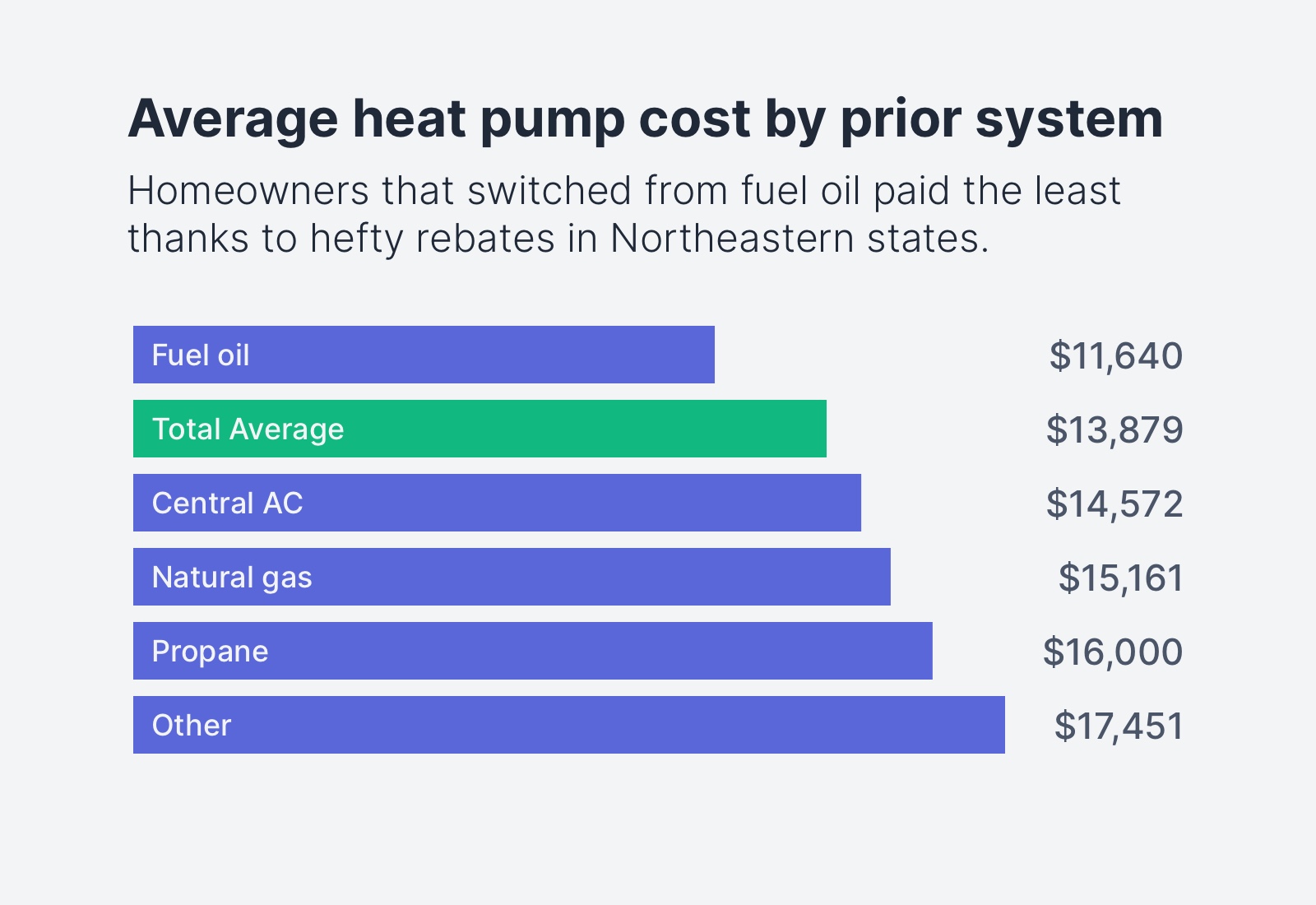
As you can see, the averages didn’t vary much, with one exception: fuel oil. The main reason for this is the fuel-switching incentives offered by states and utilities. In New York, you can get $2,500 per heating ton in rebates if you switch from gas, propane or fuel oil. In British Columbia, there are rebates up to $11,000 for fossil fuel replacements.
Two more factors to consider
Existing ducts and their condition
One factor we didn’t ask about in our survey data, but heard about from installers that we spoke to, is the condition of a home’s ducts.
Installing new ductwork, or doing major renovations to ducts, is very expensive. It’s a big commitment to open up your home’s walls or ceilings. But if your home has reasonably functional ducts where it needs them, then replacing your furnace and central air conditioning is more of a simple equipment change, hence you can expect lower costs.
Don’t get us wrong–money spent on good duct efficiency is money well spent. Most homes lose 20-30% of their cooling capability in ducts, according to Energy Star. But properly running new duct channels, or fixing what’s there, can add upfront costs.
Electrical panel upgrade
Another cost factor for some owners of older homes, or homes that mainly relied on fuel sources before a heat pump, is electrical upgrades.
Electrifying your home’s HVAC system can mean cash savings for you, and carbon savings for the planet. But your home has to be able to handle a big new electrical device. If not, upgrading your panel and service adds cost.
If you’re switching from natural gas, propane or fuel oil, you should expect at least some electrical costs, to provide the plugs and lines needed for the new equipment. But as we mentioned above, in many states switching fuels will make your home qualify for big rebates.
In part five of his Electrify Everything course, Nate Adams says that, generally, a home with 200-amp service can cover a central HVAC system, with backup heat. 100 amps can work, but it depends on what else is regularly drawing power in the home.
Richardson said that in the Boulder, Colorado area, he hasn’t had to upgrade a single 100-amp home in recent memory. Proving that a home can handle the typical load of a heat pump requires a home inventory and real-time data. But homes built to handle incandescent bulbs often have a good bit of room left after a home switches to LEDs.
As with your home heating load, it’s a good idea to have a professional do a full study of your home’s electrical status and needs.
Are heat pumps worth it?
A heat pump might seem like a hassle to upgrade, tempting some to stick with just replacing the kind of system they already have. But upfront costs are only a fraction of the whole energy picture.
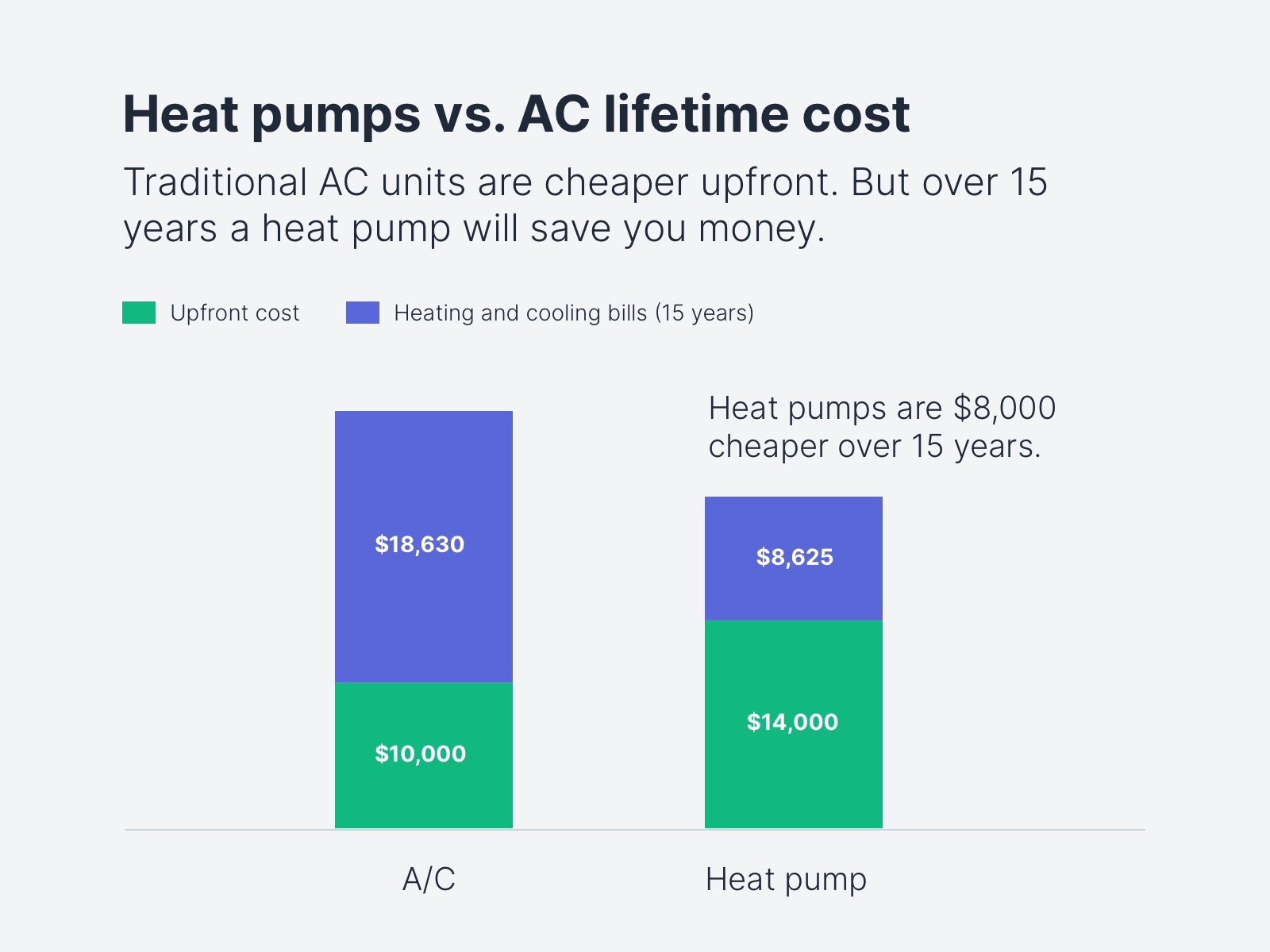
Heat pumps can save the average U.S. homeowner $10,000 throughout the unit’s lifetime. They replace both a furnace and an air conditioner, and they’re usually more comfortable and efficient than either of them. They free your budget from fluctuating fuel costs, and reduce greenhouse gas emissions.
That’s the important context for their higher upfront cost. A heat pump is usually a few thousand dollars more expensive than its rough tonnage/SEER equivalent. But it’s far more energy efficient.
If you’re comparing a heat pump versus AC, then heat pumps are the clear choice, given how much they can save you on your home’s annual heating and cooling bill. Even the high upfront cost can be offset through on-bill financing, low-to-zero interest loans offered by states and utilities, and zero-upfront cost installation companies like Sealed.
Massachusetts and California data
As a part of this research, we requested data on the cost of heat pumps from state energy efficiency program managers in California, New York, Massachusetts, Maine, Vermont, and Oregon— six states with electrification goals and strong rebate programs.
All of them responded, but only two collected data on heat pump costs: California and Massachusetts. Here’s some of what we learned analyzing their data:
Massachusetts
According to data collected as part of MassCEC’s Whole-Home Heat Pump Pilot, which ran from May 2019 through June 2021, the average cost of a heat pump in a Massachusetts single-family home was $17,721.
Like our survey results, the cost varied significantly based on the size of a home. Here’s how much the average homeowner paid based on their home’s square footage:
- Less than 1,000 square feet: $4,308
- Between 1,000 and 1,500 square feet: $10,818
- Between 1,500 and 2,000 square feet: $21,756
- Between 2,000-2,500 square feet: $20,796
- More than 2,000 square feet: $26,214
California
California hasn’t released any public data on heat pump installation costs. But program managers at TECH Clean California sent us data based on 1,880 heat pump installations between December 2021 and May 2022. The average installation cost $17,287.
Here’s how much the average homeowner paid based on their home’s square footage:
- Less than 1,000 square feet: $12,774
- Between 1,000 and 1,500 square feet: $14,762
- Between 1,500 and 2,000 square feet: $15,917
- Between 2,000-2,500 square feet: $18,857
- More than 2,000 square feet: $22,087
Future research and work needed
Given the importance of heat pumps as a climate solution, the lack of data on their cost is a huge problem. We reached out to the U.S. Energy Department and state programs like Efficiency Maine and Efficiency Vermont. None of them had any data on how much heat pumps actually cost.
As we mentioned above, Massachusetts and California were the two exceptions. Massachusetts’ Clean Energy Center’s dataset is one of the best public datasets we’ve seen in this industry. California’s, while not publicly available yet, seems promising. We hope other states and federal policymakers will follow their lead.
Our goal in producing this research was to fill some of the research void. But we’re a small team with a small budget. Our hope is that this survey and research will encourage others to one-up us with a survey 10 or 100 times the size.
If you’re interested in talking with our team before doing your own research, you can reach out to michael@carbonswitch.com. We’d be happy to share what we learned.
Frequently asked questions about heat pumps
What is a heat pump?
A heat pump is an appliance that can both heat and cool a home. They’re a modern, efficient replacement for homes that need both traditional air conditioning and a heating system, like a furnace, boiler, or baseboards.
We’ve detailed all the basics about heat pumps in our guide, What Is a Heat Pump?
How does a heat pump work?
The short version is that heat pumps use electricity to move heat from one place to another. In cooling mode, it’s a familiar method of moving heat inside your home to the outside, cooling your house. In heating mode, it’s a bit more interesting, as the heat pump takes heat energy from even the coldest air and delivers it inside.
You can go a bit deeper and learn more particulars about the science and efficiency in our guide to How Does a Heat Pump Work?
Will a heat pump work in really cold climates?
A heat pump can absolutely work in cold climates, even in places with bone-chilling temperatures. One brand of heat pumps can work down to -13 Fahrenheit, and more are in development. If your heat pump can’t reach those depths, you can use a backup system, like electric resistance strips, or keep a fuel-burning furnace on hand. And you’ll still get great heat for the non-record-low times of year.
For more on how heat pumps perform in uber-cold areas, check out our reviews of the best cold climate heat pumps.
What size heat pump do I need?
Picking out and pricing a heat pump isn’t as simple as matching it to your existing furnace or air conditioner. Many of the rules of thumb used by HVAC contractors can lead to over- or under-sized systems, and heat pumps benefit a home most when they can run constantly.
To learn the better methods of estimating and pricing out a heat pump, consult our full heat pump sizing guide.
